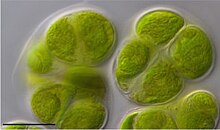Chlorokybus
| Chlorokybus | |
|---|---|

| |
| Chlorokybus atmophyticus | |
| Scientific classification | |
| Clade: | Viridiplantae |
| (unranked): | Charophyta |
| Class: | Chlorokybophyceae Irisarri & al.[5] |
| Order: | Chlorokybales Irisarri & al.[4] |
| Family: | Chlorokybaceae Irisarri & al.[3] |
| Genus: | Chlorokybus Geitler[1][2] |
| Type species | |
| Chlorokybus atmophyticus Geitler[1]
| |
| Species[1] | |
| |
Chlorokybus is a multicellular (sarcinoid) genus of basal green algae or charophyte. It has been classified as the sole member of the family Chlorokybaceae,[3] which is the sole member of the order Chlorokybales,[4] in turn the sole member of the class Chlorokybophyceae.[5][6] It grows on soil and rock surfaces,[7] and is rare.[8]
Description
[edit]Chlorokybus is a microalga forming sarcinoid, cubical packets of two to eight cells. Each cell contains a single chloroplast which contains a central pyrenoid surrounded by grains of starch, as well as another pyrenoid (called the pseudopyrenoid) near the edge of the chloroplast which lacks starch grains. Mature packets produce a layer of mucilage surrounding the cells.[7]
Chlorokybus reproduces asexually by forming autospores. The autospores can also differentiate into zoospores, which have two flagella. Zoospores can form groups of up to 32 cells. Zoospores swim to a new location and then settle, retracting their flagella and creating a new vegetative cell.[7]
Taxonomy
[edit]Chlorokybus atmophyticus was once thought to be the only species in the genus.[8] In 2021, a study showed that there were at least four other species, morphologically indistinguishable, but with deep genomic differences, suggesting divergences possibly about 76 million years ago. Chlorokybus has been found in Eurasia, Central and South America.[7]
Chlorokybus was placed in a new class, order and family. The new class Chlorokybophyceae was basal within the charophytes.[7]
Within the genus, the species were related as shown in the cladogram:[7]
| Chlorokybus |
| ||||||||||||||||||||||||
References
[edit]- ^ a b c Guiry, M.D.; Guiry, G.M. "Chlorokybus". AlgaeBase. University of Galway.
- ^ Geitler, L. (1942). "Morphologie, Entwicklungsgeschichte und systematik neuer bemerkenswerter atmosphytischer Algen aus Wien". Flora NF. Vol. 136. pp. 1–29.
- ^ a b Guiry, M.D.; Guiry, G.M. "Chlorokybaceae". AlgaeBase. University of Galway.
- ^ a b Guiry, M.D.; Guiry, G.M. "Chlorokybales". AlgaeBase. University of Galway.
- ^ a b Guiry, M.D.; Guiry, G.M. "Chlorokybophyceae". AlgaeBase. University of Galway.
- ^ Leliaert, Frederik; Verbruggen, Heroen; Zechman, Frederick W. (2011). "Into the deep: New discoveries at the base of the green plant phylogeny". BioEssays. 33 (9): 683–692. doi:10.1002/bies.201100035. ISSN 0265-9247. PMID 21744372. S2CID 40459076.
- ^ a b c d e f Irisarri, Iker; Darienko, Tatyana; Pröschold, Thomas; Fürst-Jansen, Janine M. R.; Jamy, Mahwash & de Vries, Jan (2021). "Unexpected cryptic species among streptophyte algae most distant to land plants". Proceedings of the Royal Society B: Biological Sciences. 288 (1963): 20212168. doi:10.1098/rspb.2021.2168. PMC 8611356. PMID 34814752.
- ^ a b Rogers, Catherine E.; Mattox, Karl R.; Stewart, Kenneth D. (1980). "The Zoospore of Chlorokybus Atmophyticus, a Charophyte with Sarcinoid Growth Habit". American Journal of Botany. 67 (5): 774–783. doi:10.1002/j.1537-2197.1980.tb07706.x. JSTOR 2442669.
